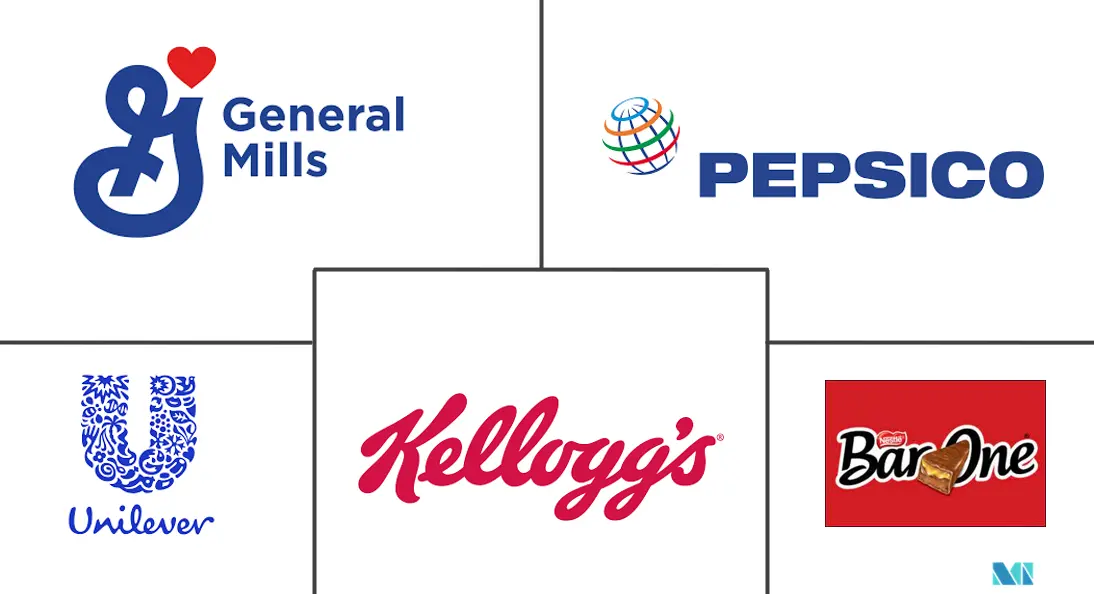Market Size of Asia Pacific Snack Food Industry

| Study Period | 2019 - 2029 |
| Base Year For Estimation | 2023 |
| Forecast Data Period | 2024 - 2029 |
| Historical Data Period | 2019 - 2022 |
| CAGR | 8.10 % |
| Market Concentration | Low |
Major Players
*Disclaimer: Major Players sorted in no particular order |
APAC Snack Food Market Analysis
Asia Pacific Snack Food Market is projected to register a CAGR of 8.1% during the forecast period, 2022-2027.
The market in the region is primarily driven by the high demand for packaged snack products such as cookies, chips, noodles, and macaroni, especially among teenagers and corporate workers. This trend is expected to sustain during the forecast period, as snack manufacturers are focusing on product innovations to launch clean-label varieties including, organic, dairy-free, sugar-free, etc. Additionally, the shifting lifestyles and dietary patterns, have also fuelled demand for low-calorie and zero-sugar snacking options. Moreover, a significant trend fueling the industry is the rising demand for vegan, allergen-free snacks. International brands have seized this opportunity of increased demand for snacks, by providing products in more convenient packaging formats to extend shelf life and promote on-the-go snack consumption. For instance, brands are offering snacking products in an Eco-Lok closure packaging solution, which enables consumers to reclose the package and consume the snacks later.
Furthermore, COVID-19 led to a major consumer shift, as customers are no more brand loyal in developing countries, and they are trying new brands in the low-stock environment. Frequent lockdowns that occurred due to the pandemic in the region have led to the work-from-home culture which has prompted an increase in at-home consumption of snack food products.
APAC Snack Food Industry Segmentation
A snack is a small portion of food eaten between meals. Snacks come in a variety of forms and shapes, including packaged snack foods and other processed foods. The Asia-Pacific snack food market is segmented by product type, distribution channel, and country. By product type, the market is segmented into savory snacks, frozen snacks, confectionery snacks, fruit snacks, bakery snacks, and other product types. By distribution channel, the market is segmented into supermarkets/hypermarkets, convenience stores, online retail channels, and other distribution channels. By geography, the market is segmented into China, Japan, India, Australia, and the Rest of Asia-Pacific. For each segment, the market sizing and forecasts have been done on the basis of value (in USD million).
| By Product Type | |
| Savory Snacks | |
| Frozen Snacks | |
| Confectionery Snacks | |
| Fruit Snacks | |
| Bakery Snacks | |
| Other Product Types |
| By Distibution Channel | |
| Supermarkets and Hypermarkets | |
| Convenience Stores | |
| Online Retail Channels | |
| Other Distribution Channels |
| By Geography | |
| China | |
| Japan | |
| India | |
| Australia | |
| Rest of Asia-Pacific |
Asia Pacific Snack Food Market Size Summary
The Asia Pacific snack food market is experiencing significant growth, driven by a rising demand for packaged snacks such as cookies, chips, noodles, and macaroni, particularly among teenagers and corporate workers. This demand is further fueled by lifestyle changes and dietary shifts towards low-calorie and zero-sugar options, as well as a growing interest in vegan and allergen-free snacks. Snack manufacturers are responding with product innovations, including clean-label varieties and convenient packaging solutions that extend shelf life and facilitate on-the-go consumption. The COVID-19 pandemic has also influenced consumer behavior, with increased at-home snacking and a willingness to try new brands in developing countries. The market is characterized by a diverse range of products, including frozen, bakery, savory, and confectionery snacks, catering to the needs of busy individuals and health-conscious consumers.
The competitive landscape of the Asia Pacific snack food market is marked by the presence of numerous brands and players offering a wide array of products such as nuts, seeds, trail mixes, and flavored snacks. Key companies like PepsiCo, Kellogg, Nestle, and General Mills are focusing on new product launches, expansions, and strategic partnerships to meet the growing consumer demand. Innovations in flavors and ingredients, supported by advancements in extrusion technology, are enhancing the appeal of snack foods. The market is also witnessing the introduction of health-oriented products, such as energy bars and nut-based snacks, to cater to fitness enthusiasts. With a low market concentration in developing countries like India and China, major players are strengthening their distribution channels and exploring e-commerce opportunities to gain a competitive edge.
Asia Pacific Snack Food Market Size - Table of Contents
-
1. MARKET DYNAMICS
-
1.1 Market Drivers
-
1.2 Market Restraints
-
1.3 Porter's Five Force Analysis
-
1.3.1 Threat of New Entrants
-
1.3.2 Bargaining Power of Buyers/Consumers
-
1.3.3 Bargaining Power of Suppliers
-
1.3.4 Threat of Substitute Products
-
1.3.5 Intensity of Competitive Rivalry
-
-
-
2. MARKET SEGMENTATION
-
2.1 By Product Type
-
2.1.1 Savory Snacks
-
2.1.2 Frozen Snacks
-
2.1.3 Confectionery Snacks
-
2.1.4 Fruit Snacks
-
2.1.5 Bakery Snacks
-
2.1.6 Other Product Types
-
-
2.2 By Distibution Channel
-
2.2.1 Supermarkets and Hypermarkets
-
2.2.2 Convenience Stores
-
2.2.3 Online Retail Channels
-
2.2.4 Other Distribution Channels
-
-
2.3 By Geography
-
2.3.1 China
-
2.3.2 Japan
-
2.3.3 India
-
2.3.4 Australia
-
2.3.5 Rest of Asia-Pacific
-
-
Asia Pacific Snack Food Market Size FAQs
What is the current Asia Pacific Snack Food Market size?
The Asia Pacific Snack Food Market is projected to register a CAGR of 8.10% during the forecast period (2024-2029)
Who are the key players in Asia Pacific Snack Food Market?
KELLOGG , Unilever , Pepsico, General Mills. and Nestle are the major companies operating in the Asia Pacific Snack Food Market.

